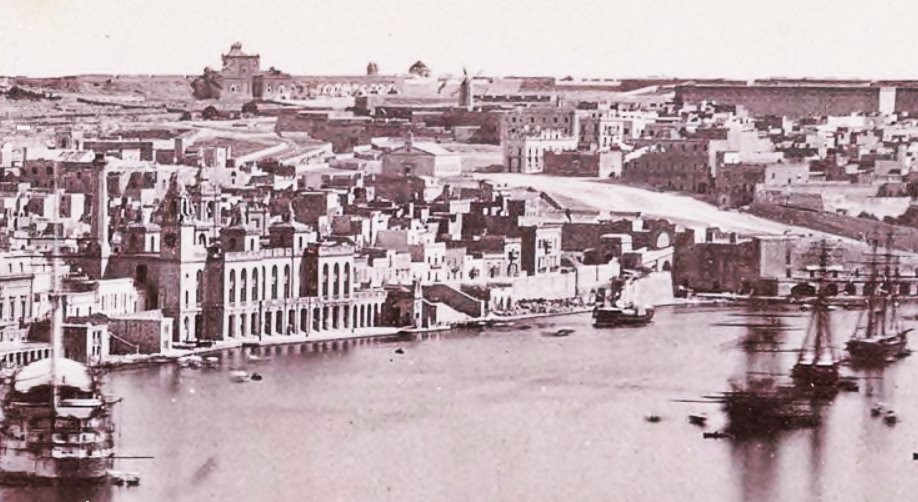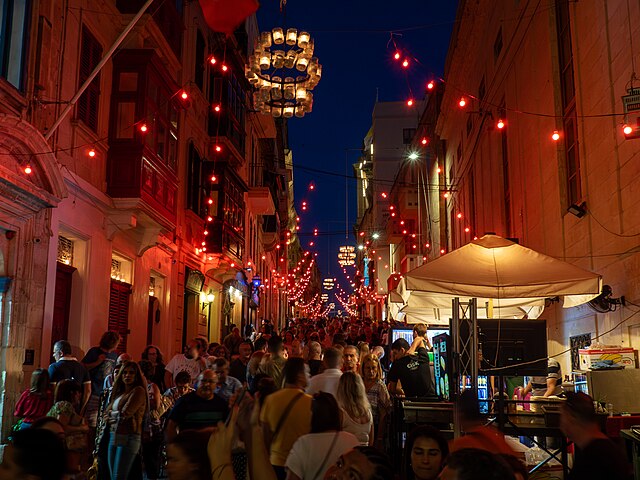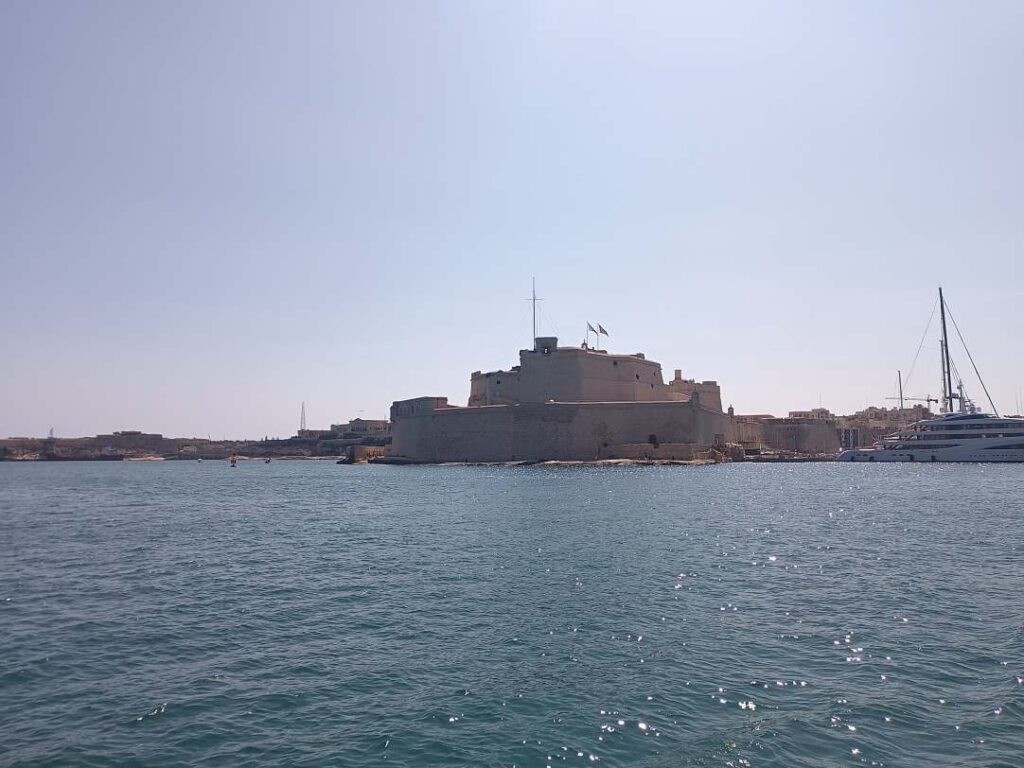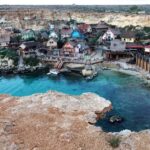| Malta Short Let: Cozy Stay in Gzira | |
|
Sliema Area Modern Designer Finished 2 Bedrooms + Games Room. First floor with Maltese Balcony Large back Terrace with swinging sofa Fully Airconditioned + Full Kitchen 3 TVs, including 65” with backlight. |
 |
|
Book Now: Google Travel | Direct (Cheapest) | Booking.com | Airbnb |
|
Where is Birgu?
Birgu is in Malta, and Birgu is one of several cities surrounding the great harbour of Malta.

Birgu’s streets once bustled with the activity of skilled craftsmen and merchants. Local artisans practiced traditional trades like shipbuilding (learn more about Maltese Traditional Boats), metalworking, and pottery. Merchants set up stalls along busy streets, offering spices, fabrics, and precious items brought from afar. This blend of Maltese and foreign influences created a vibrant, multicultural atmosphere that made Birgu feel more like a bustling Mediterranean port city than a small Maltese town.

Today, traces of this artisanal spirit remain. Small shops still line the streets, and local craftsmen offer visitors a chance to purchase handmade goods steeped in tradition. Walking through the market areas, one can easily imagine the sights and sounds of Birgu’s past—vendors calling out to passersby, the clink of coins, and the scent of exotic spices. It’s an authentic experience that connects visitors to the everyday lives of the people who once filled these spaces.
Birgu’s artisans and tradespeople contributed to more than just the local economy; they helped shape the town’s character. Their craft and dedication are preserved in the town’s spirit, and visitors today can still witness and support this heritage by exploring the shops and stalls that carry on the legacy of Maltese craftsmanship.

The Great Siege of 1565: Birgu’s Defining Moment
Perhaps no event has left a greater mark on Birgu than the Great Siege of 1565. For months, the Ottoman Empire, under the command of Suleiman the Magnificent, launched a relentless assault on Malta, aiming to conquer the island and expand their reach into Western Europe. Birgu, with Fort St. Angelo at its heart, became the focal point of this epic struggle, as the Knights and the Maltese people united to defend their home against a far superior force. Before St Angelo there was even another castle Castrum Maris.
The Siege tested the resilience of both the defenders and the fortifications they relied upon. It was in Birgu’s narrow streets and along its towering walls that some of the most intense battles took place. Grand Master Jean de Valette, the Order’s leader and strategist used excellent military tactics and , directed the defense from within Birgu, inspiring courage among the knights and locals alike. His leadership and the indomitable spirit of Birgu’s defenders turned the tide of the siege, culminating in a hard-won victory that would go down in history as one of the Mediterranean’s most significant battles. The Knights exploited the Ottomans strategic mistakes and won!
For visitors, walking through Birgu’s historical sites tied to the Great Siege is a deeply moving experience. From Fort St. Angelo to the walls and bastions that once stood as the last line of defense, every stone seems to whisper stories of heroism and sacrifice. This victory marked a turning point, not just for Malta but for all of Europe, curtailing Ottoman expansion and solidifying the importance of Malta’s position in the Mediterranean. Why did the the Ottomans fail and the French succeeded?
Learn More: Piracy naval Tactics used by the Corsairs of Malta.
Birgu and the French Invasion of 1798
During the French invasion of 1798, Birgu experienced a dramatic shift from its storied past as the first home of the Knights of Malta. Despite its formidable medieval fortifications that had once withstood the Ottoman siege of 1565, the city fell quickly to Napoleon’s modern military tactics. The French promptly established Fort St. Angelo as one of their main bases, transforming this symbol of Knights’ power into their own stronghold. However, the story didn’t end with the initial invasion. When the Maltese people rose up against French rule, Birgu found itself caught in the crossfire.
The French troops retreated into the harbor cities, including Birgu, where they found themselves under blockade by Maltese insurgents supported by British and Portuguese forces. The city’s residents endured significant hardships during this period as their homes became a battleground.
This tumultuous time marked the end of an era for Birgu – after nearly 270 years as the Knights’ city, it was now witnessing the dramatic finale of their rule amid the chaos of siege and resistance. The French occupation left its mark not just on Birgu’s buildings and institutions, but on the very fabric of its society, marking a decisive turning point in the city’s long history.
Birgu as part of the Three Cities
Valletta and Isla hold unique, interconnected roles with Birgu in Maltese history, each contributing to the transformation of the southern harbor area. Initially, Birgu served as Malta’s capital when the Knights of St. John arrived in 1530, due to its natural harbor and fortifications. However, as Birgu evolved into a strategic and fortified hub, the neighboring areas also grew in significance. Bormla and Isla developed as complementary towns, benefiting from Birgu’s thriving market economy.
The foundation of Isla (Senglea), proposed by Grand Master Claude de la Sengle in 1551, was a direct response to external threats, notably after Gozo suffered a significant Ottoman assault that year. This led the Order to recognize the need for additional fortifications around the harbor, transforming Isla into a fortified area and residential suburb, later known as Città Invicta after its role in resisting Ottoman forces during the Great Siege of 1565.
Learn more : Discover the history of the Three Cities before the arrival of the Knights.
Birgu and Valletta
Following the foundation of Valletta in 1571, Birgu experienced a gradual decline in its political prominence but retained significant economic and social roles. The Knights of St. John shifted their administrative center across the Grand Harbour, which meant that many of Birgu’s institutions—once pivotal in Maltese governance—were either relocated or amalgamated with their counterparts in Valletta. Learn more: The knights of Malta after the great Siege.
However, the relocation was not abrupt; Birgu continued to function as a major urban area while Valletta built its population and infrastructure. Even as Valletta rose to become the official capital, Birgu remained Malta’s principal port, a bustling center for merchants, fishermen, and the primary arsenal for the Order’s galleys.
Despite the shift in political power, Birgu’s commercial markets continued to thrive. Many shops and taverns remained active, serving locals and travelers, and shops in Birgu often competed with those in Valletta, as merchants found Birgu’s established markets profitable. Furthermore, the presence of the Roman Inquisition in Birgu maintained its importance as a religious and judicial center well into the 17th century, with some critical roles left in place for the local communities. Over time, Birgu, along with nearby Isla and Bormla, collectively known as the Three Cities, became characterized by vibrant marketplaces, bustling with high-quality goods. This trend helped reinforce the Three Cities as key urban and economic hubs despite the official designation of Valletta as the capital. Valletta has it’s own fort: St Elmo
Experiencing Birgu Today: A Living History

Birgu today is a place where history is not just remembered but actively celebrated. The town hosts several annual events that bring its heritage to life, allowing visitors to step into the past and experience the town’s cultural depth firsthand. One of the most anticipated events is Birgufest, held every October. During this festival, the town is illuminated by thousands of candles, creating a magical atmosphere that highlights its historic architecture and offers a unique way to experience Birgu’s medieval charm. Traditional music, local delicacies, and artisanal crafts further enrich the experience, drawing both locals and tourists into Birgu’s warm and welcoming community.
The Inquisitor’s Palace is another must-see for visitors, offering guided tours that explore Malta’s inquisitorial history. Originally built in the 16th century, this palace served as both a residence and courtroom for the Inquisitors appointed by the Pope. The palace is one of the few remaining buildings of its kind in Europe, and walking through its chambers and courtyards offers insight into the judicial and religious tensions that once shaped Maltese society. It’s a fascinating stop that sheds light on an often-overlooked aspect of Malta’s history.
Another remarkable site is the Maritime Museum, housed in an old naval bakery near the waterfront. The museum delves into Malta’s nautical past, exploring the island’s role as a maritime hub. Exhibits range from ancient anchors and ship models to artifacts from the British colonial period. Visiting the museum provides a broader context for Birgu’s relationship with the sea and reveals the deep-rooted connection that Maltese people have with their maritime heritage.
For those who prefer a more leisurely pace, Birgu’s compact size makes it ideal for self-guided walking tours. Begin at Fort St. Angelo, then wander through the town’s labyrinthine streets, discovering its historic buildings, small courtyards, and hidden gems along the way. As you explore, you’ll find cafes, artisan shops, and picturesque viewpoints that invite you to pause and soak in the town’s timeless atmosphere.
Savoring the Present in Birgu’s Historic Setting
No visit to Birgu would be complete without indulging in some local Maltese cuisine. The town’s waterfront area is home to a variety of cafes and restaurants, where visitors can enjoy dishes that blend traditional Maltese flavors with Mediterranean influences. Fresh seafood, rich stews, and savory pastizzi (a beloved Maltese pastry) are just a few of the culinary delights awaiting visitors. Dining by the water, with views of the Grand Harbour and Fort St. Angelo, creates a setting that feels as timeless as the town itself.
Birgu is also known for its crafts, and those looking for unique souvenirs will find plenty of options. Handcrafted silver filigree jewelry, Maltese lace, and ceramics are among the traditional items that reflect Malta’s artisanal heritage. These crafts make for meaningful keepsakes, offering visitors a way to take a piece of Birgu’s legacy home with them. Supporting local artisans is not only a way to honor Maltese traditions but also a reminder of the craftsmanship that has been passed down through generations.
For a truly immersive experience, consider staying overnight in Birgu. There are charming guesthouses and boutique hotels that provide a more personal connection to the town’s heritage. Waking up in Birgu, with its quiet streets and historic architecture, allows visitors to experience a side of Malta that is often missed in the more bustling areas. Staying here lets you slow down, enjoy a leisurely breakfast by the harbor, and appreciate the timeless beauty of a town that has preserved its essence.
Conclusion: Birgu, the City That Bridges Past and Present
Birgu may not be Malta’s capital anymore, but in many ways, it is the heart of Maltese heritage. It is a place where the past is not just preserved but lived, where every corner and courtyard tells a story. For anyone with a love of history, Birgu offers an experience that goes beyond simple sightseeing. Here, visitors can walk in the footsteps of knights, witness the resilience that defined Malta’s history, and feel connected to a community that cherishes its roots.
Whether you come for the fortresses, the festivals, or the quiet charm of its narrow streets, Birgu promises an encounter with history that is as rich and complex as the town itself. It’s a place that invites you to be part of its story, to learn, to explore, and to feel the spirit of Malta in a way that few other places can offer. For history buffs, cultural enthusiasts, and curious travelers alike, Birgu is more than a destination—it’s a journey into the heart of Malta’s heritage, a place where the echoes of the past still resonate and invite you to explore.
Learn more : How to get to Malta? and Is Malta Safe ? (Yes, as there are no Invaders and Pirates anymore!)
References
- Bradford, Ernle. The Great Siege: Malta 1565. London: Penguin Books, 2003.
- Buttigieg, Emanuel. “Growing Up in Hospitaller Malta (1530–1798): An Overview.” In Religion, Ritual, and Mythology: Aspects of Identity Formation in Europe, edited by Joaquim Carvalho, 97–112. Pisa: Edizioni Plus, 2006.
- Camilleri, Maroma, ed. Besieged: Malta 1565. Valletta: Malta Libraries and Heritage Malta, 2015.
- Dalli, Charles. “Behind the Walls, Beyond the Shores: The Urbanization of Malta.” In Il Mediterraneo delle Città: Temi di Storia, edited by E. Iachello and P. Militello, 79–95. Milan: Franco Angeli, 2011.
- Gambin, Kenneth. The Inquisitor’s Palace. Valletta: Heritage Malta, 2003.
- Mallia-Milanes, Victor. Valletta: Malta’s Hospitaller City and Other Essays. Valletta: Midsea Books, 2019.
- Spiteri, Stephen. The Great Siege of Malta: Knights vs Turks, 1565. Malta: Kite Group, 2011.
- Vella, Andrew P. “The Order of Malta and the Defense of Tripoli 1530–1551.” Melita Historica 6, no. 4 (1975): 375–394.
- Attard, Jason. “Mid-Sixteenth Century Birgu: A Study of the Acts of Notary Giacomo Baldacchino, 1551–1552.” B.A. honors dissertation, Department of History, University of Malta, 2004.
- Fiorini, Stanley. “The Rhodiot Community of Birgu, A Maltese City: 1530–c. 1550.” In Library of Mediterranean History, edited by V. Mallia Milanes, 211–232. Malta: Mireva Publications, 1994.








